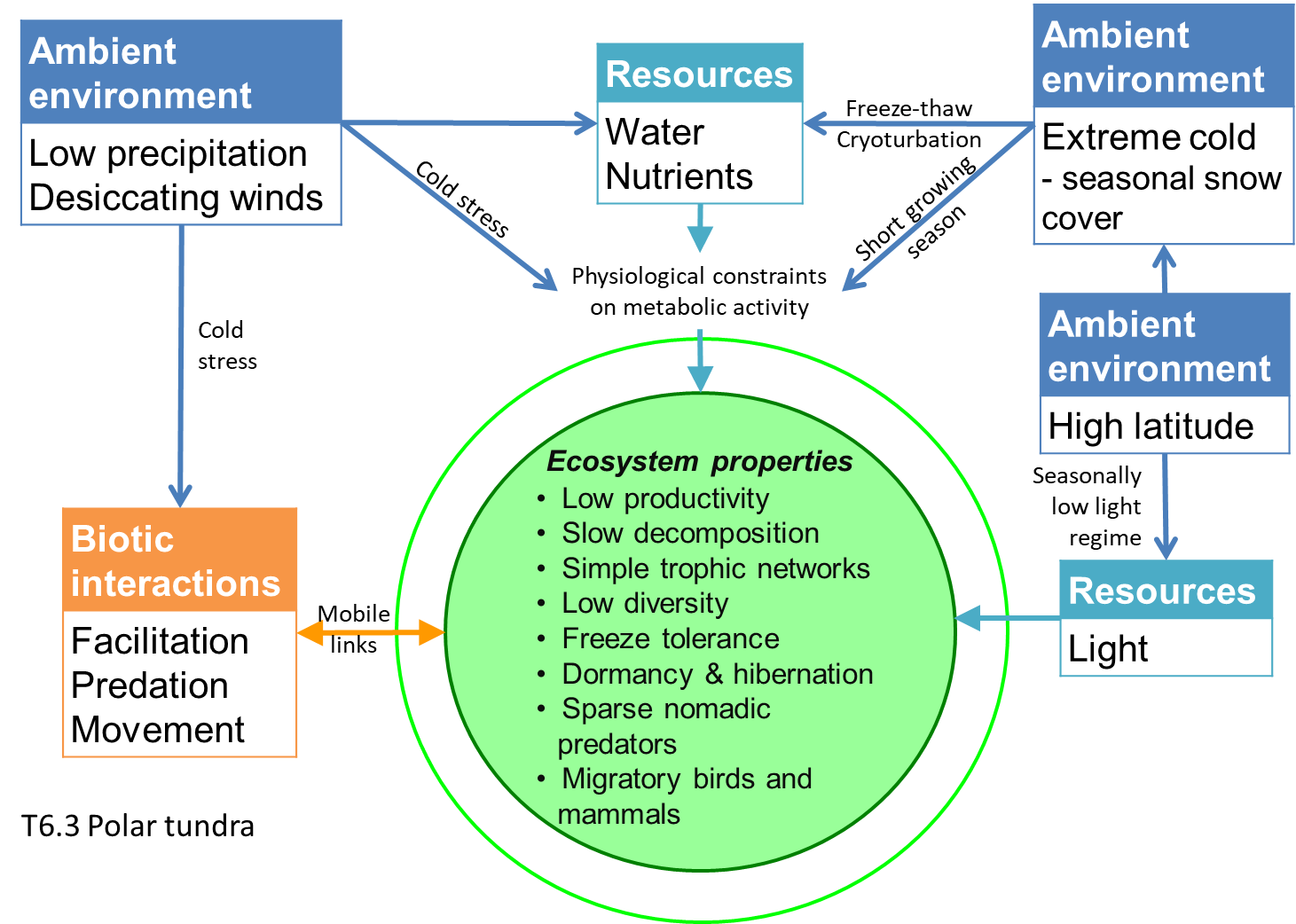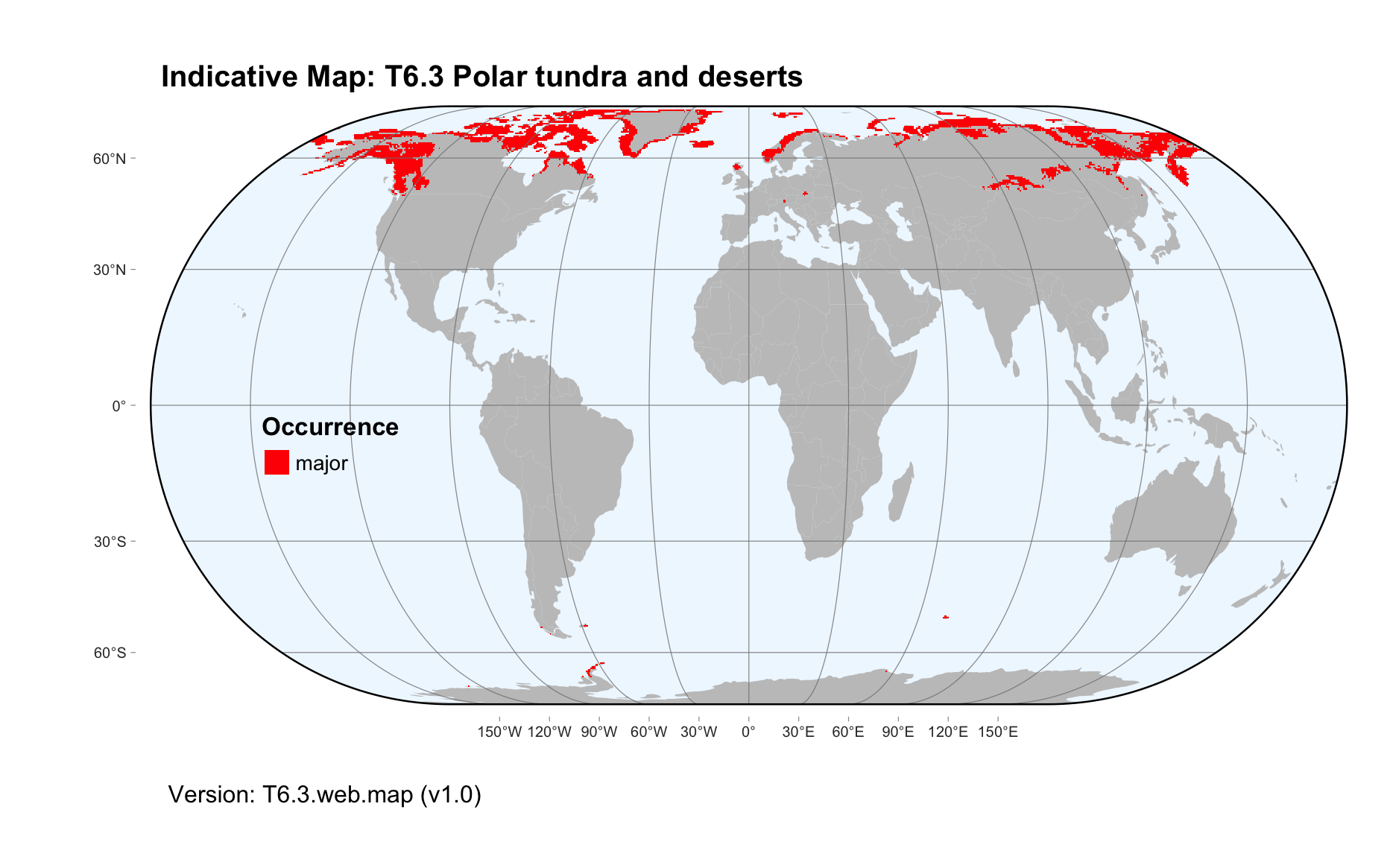Global ecosystem typology
Alternative site for the Global ecosystem typology with additional information for ecosystem profiles and indicative maps.
This site is maintained by jrfep
T6.3 Polar tundra and deserts
Biome: T6. Polar/alpine (cryogenic) biome
Contributors:
(texts)
Polar tundra and deserts have continuous to sparse cover of cold-tolerant mosses, liverworts, lichens, grasses, low shrubs and other flowering plants. They occur primarily in the Arctic circle, but polar desert is found in dry coastal lowlands of Antarctica. Precipitation falls as snow, with seasonal snow cover limiting the growing season. Extreme cold temperatures and short growing seasons exclude trees, as well as vascular plants in the coldest and driest locations. Permafrost substrates accumulate peat through slow decomposition rates. Migratory birds feed in distant wetlands or open oceans, and contribute nutrients to the system through guano, as well as dispersing seeds and other organisms. Migratory or hibernating mammals include seals, and, in the north, polar bears, foxes and wolves.
Key Features
Open and low vegetation of herbaceous plants (e.g. tussocks, cushions, rosette plants) and abundant kryptogams in very cold climates with permafrost.
Overview of distribution
Locally in northern Europe (Scandinavia, Russia), northern Siberia and North America.
Profile versions
- v1.0 (2020-01-20): DA Keith; D Faber-Langendoen
- v2.0 (2020-05-31): DA Keith; F Essl; KR Young; CH Körner
- v2.01 ():
- v2.1 (2022-04-06): DA Keith; F Essl; KR Young; CH Körner Full profile available at official site
Main references
Selected references for this functional group:
Crawford RMM (2013) Tundra-taiga biology. Ch 5. Oxford University Press, Oxford.
Paulsen J, Körner C (2014) A climate-based model to predict potential treeline position around the globe Alpine Botany 124, 1-12 DOI:10.1007/s00035-014-0124-0
Diagrammatic assembly model

Maps
Maps are indicative of global distribution patterns are not intended to represent fine-scale patterns. The maps show areas of the world containing major (coloured red) or minor occurrences (coloured yellow) of each ecosystem functional group. See general notes on maps.
There are 2 alternative versions of the indicative map for this functional group, please compare description and sources below.
T6.3.IM.alt_v2.0
Datasets
- KG-climate-2018
- glUV1.0
Map references
Beck, H., Zimmermann, N., McVicar, T. et al. (2018) Present and future Köppen-Geiger climate classification maps at 1-km resolution Sci Data 5, 180214 DOI:10.1038/sdata.2018.214
Beckmann M., Václavík T., Manceur A.M., Šprtová L., von Wehrden H., Welk E., Cord A.F. (2014) glUV: A global UV-B radiation dataset for macroecological studies Methods in Ecology and Evolution 5: 372–383. DOI:10.1111/2041-210X.12168
T6.3.web.map_v1.0

Datasets
- KG-climate-2018
- glUV1.0
Map references
Beck, H., Zimmermann, N., McVicar, T. et al. (2018) Present and future Köppen-Geiger climate classification maps at 1-km resolution Sci Data 5, 180214 DOI:10.1038/sdata.2018.214
Beckmann M., Václavík T., Manceur A.M., Šprtová L., von Wehrden H., Welk E., Cord A.F. (2014) glUV: A global UV-B radiation dataset for macroecological studies Methods in Ecology and Evolution 5: 372–383. DOI:10.1111/2041-210X.12168
Check: the Glossary / Profile structure / the public document